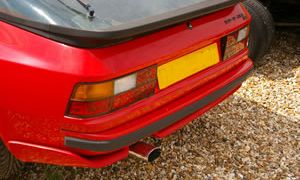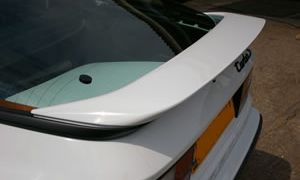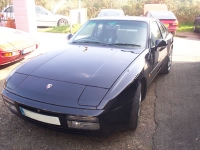You have chosen to buy a Porsche 944. Congratulations! An excellent and widely undervalued sports car. Probably the best kept secret of the Porsche marque.
This will be a particulary long article because the 944 had a 10 year run of production and the multitude of sub-models and options. Hopefully it will be helpful in choosing your future Porsche 944.
In the 1970's, Porsche had designed and developed the Porsche 924 with a 2.0 litre engine, and by 1982, Porsche had released the Porsche 944 - an evolution of the 924 with an all-new Porsche 2.5 four cylinder engine, wider coachwork aerodynamically designed for the 924 Carrera GT, and much of the car redesigned and updated. Like the 924, the 944 enjoys near 50-50 weight distribution which makes it a very stable car that handles like a dream.
Designed by Harm Lagaay of Porsche-AG, the 944 is also a favorite with both Jeremy Clarkson of TopGear and Sun / Sunday Times fame, and Tiff Needel of TopGear and 5thGear fame (as well as touring car racing)/ They both often lament about memories of the Porsche 944 Turbo, which is no surprise - the 944 really is a drivers car, with the turbo having unparalleled performance in its day.
By now you should have read our Porsche Buyers Guide Introduction - if not, read it now, as this article will try to avoid repeating what we have already covered in that article. Instead, this article will concentrate on the model specific information and what to look for when buying a 944.
Chronology of the Porsche 944
- 1982 - Launch of the model featuring a 2.5 litre normally aspirated, electronically managed engine, with wide flared arches and 'Cookie Cutter' wheels. In the UK, the standard car was sold as a "Lux" featuring as standard an electric sun roof, alloy wheels, electric windows, electrically heated mirros, heated rear wipe tailgate with electrical release from inside the cockpit. In other markets a more basic specification was available. Power steering, Air conditioning and leather seats were expensive options rarely taken. Other options such as headlight washers, rear slotted (toast rack) lower valance, box sills and many more were also available;
- 1986 - Complete face lift to the 944 model, with revised suspension (aluminium arms), electrical system updated and the interior changed to what is known as the oval dashboard. In the UK, the standard or 'Lux' specification now includes power steering, an antenna within the windscreen, central locking, basic alarm system and basic immobiliser. Additional options now included Fuchs wheels;
- 1986 - Turbo model introduced - 220 BHP, rear lower spoiler as standard, single piece front bumper (PU). Typically fitted with 16 inch teledial wheels;
- 1987 - All models updated to use different suspension geometry with new suspension arms and shallower offset wheels;
- 1987 - 944 S Model introduced with 2.5 Litre engine, now with 16 valve cylinder head and similar appearance as 944 Lux or base models.
- 1988 - 944 Turbo S and Silver Rose models released, 250 bhp, limited slip differential, MO30 suspension, M030 larger brakes as standard, Forged CS wheels, made in Stuttgart rather than Neckarsulm and usually without sunroof (option included to have it). Non-S turbo version still available and manufactured in Neckarsulm;
- 1989 - 944 Turbo SE (controversial model) manufactured in Neckarsulm in Germany as with other 944 models version of the 944 Turbo S available. All other Turbo versions now 250 BHP as standard. Any car could be optioned to include all Turbo S items. Standard Turbo wheels are now Design 90 type;
- 1989 - 944 Lux revised to have 2.7 Litre engine, fitted with standard with 15 inch teledial wheels, available with automatic or manual transmission.
- 1989 - 944 S2 released. Turbo body with 3.0 Litre, 16 Valve engine. Options include 10 speaker audio, LSD transmission, M030 Suspension, M030 Brakes, sports seats and much more. Usually fitted with Design 90 wheels, as standard;
- 1990 - 944 S2 also available as carbriolet version;
- 1990 - Lux model discontinued;
- 1990 - S2 and Turbo models now fitted with Bridge spoiler rather than rubber spoiler;
- 1991 - 944 Turbo Cabriolet available;
- 1992 - Production of 944 has ended, due to the ecconomic climate and the renaming of the model to the '968'. Some models were still available unregistered for some time afterwards.
Bodywork
The Porsche 944 was galvanised at the factory. This is a simple coating to the bodywork which inhibits rust formation. In reality this system has worked very well, but now, some three decades after the launch of the car, the evil rust is begining to become a problem on some examples, so is something to look out for. In particular rust tends to form in the following locations:
- rear of sills on the outside. Often seen as bubbling of the stone chip textured paint coating;
- Rear of sills on the inside. Check between the inner sill and the rear suspension beam for a hole forming about 6 inches in front of the rear wheel arch on the inside, easily reached by holding the bottom of the sill and probing with your fingers;
- Front wing bottoms. The lower trailing edge of the wheel arch accumulates a lot of road debris, which then causes the bottom of the wings to corrode. Look for blisters, orange staining and probe this area. If it makes a crunching noise, it needs repairing. New front wings are expensive, however a good bodyshop can rebuild this area in steel;
- Front wings where they meet the front bumper. Not often serious or holed, but it is becoming more common to see some rust blisters forming in this area;
- Between back bumper and back panel right bellow the Porsche script decal. I believe that for some reason insufficient paint was applied by the factory in this area, as the inside edge from the luggage area always seems to be fine, but often blisters can be seen between the bumper and the back panel. These are normally superficial;
- Around the windscreen, again usually superficial, but for some reason it seems occasionally the 944 can blister around the windscreen trim.

Originally from the factory, the 944 Turbo and S2 had a rear wing under the back bumper. All models should have a boot spoiler, either rubber (as shown on the red car here) for all pre 90 models, or an ABS Plastic one on on post 1990 cars, known as the bridge spoiler (as shown in the white car here).

Lux and S models have a seperate front bumper and front valance. The Turbo and S2 models have an all in one front bumper known as a PU.
Interior
Early interiors were available in fabric or leather, typically with manual adjustments. Post-1986 cars more often have electrical adjustment of the seats, however it was an optional extra sometimes only found on the drivers seat.
Early cars also share the same dashboard as the 924, however for 1986 models, Porsche indroduced a new dashboard and door cards to update the appearance of the car.
Later cars have an option for a higher quality sound system, including multiple speakers in the doors under the arm rest area where the door pocket normally resides.
If the interior is fabric, make sure the fabric is not torn or threadbare as replacement cloths to retrim a section - although still available - cost anything up to £1,000 per square metre!
The leather interiors are far more hard wearing, but larger sports seat bolsters do suffer serious wear and can be expensive to repair or replace.
Suspension
The later post-1986 models have aluminium suspension arms on the front and rear. As of 1987, these components were updated to change the wheel offset required and the suspension geometry - this is said to have been to improve handling, although many report that the pre-87 cars are more track biased in handling.
Earlier cars, when requiring ball joint replacement for the front wishbones, are cheaper to replace than the later suspension arms which are a sealed unit. Once the ball joint is worn, a new wishbone is the official repair. However rebuild kits are available in the aftermarket, as are reconditioned wishbones.
Ball joint issues usually manefest in a 'clunk' from the front suspension when manovering.
Some post-1989 cars may have sealed non-servicable suspension struts at the front which are expensive to replace, or they are fitted with the optional Koni M030 suspension. A new alternative for repair of the sealed variety, would be to refurbish the struts with special Koni inserts, or an option for both types would be to upgrade to KW suspension, although it is a more expensive option. The M030 suspension can be rebuilt, although not cheaply.
944 models do benefit from shock absorber replacement every 50,000 miles.
The power and non-power steering racks are usually trouble free, however the power steering pumps can leak. Recommended repair of the power steering pump would be to exchange your old unit for a rebuilt one, and is an inexpensive exercise. A tell tale sign of the pump leaking would be groaning on tight turning of the suspension, and the front anti-roll bar bush on the drivers side swelling (as the power steering fluid tends to attack the bush). The bush is not expensive to replace, but should be checked as it is a good indicator of a leaking power steering pump.
Brakes
As standard the non-turbo and S2 versions of the 944 are fitted with single piston calipers all round, with vented brake disks. These are usually trouble free, although they can require attention as they age.
The standard 944 Turbo and S2 brake calipers, as well as the M030 brake calipers fitted as an option, are made by Brembo and can be expensive to service and repair. In particular, they can suffer from slider plate lift, which then can cause issues with binding brakes and problems changing the brake pads. Ask any vendor of a car you are looking at if the slider plates had been replaced. They typically need it every five to ten years.
The MO30 brake disks are very large at the front and are more expensive than the normal ones to replace, although this should not put you off buying an M030 equipped car.
All types of brakes should stop the car without very much fuss. ABS equipped models have a very compentent ABS system which works well in both wet and dry conditions. This ABS system is usually trouble free and not difficult to repair.
If the brake disks look to be scored or have a lip around the outside edge, it is recommended the the disks and pads are replaced. Most models also feature pad wear sensors which should illuminate a warning lamp on the dashboard when they require replacement.
Engine
The 944 engines all use an aluminium block, using a technology called Alusil. The engines have aluminium bores, which are very hard wearing, but can be suceptable to scoring which can cause oil consumption, although this is usually a sign of another problem and is not common.
The engines were available in several configurations as follows.
- 8-Valve 2.5 Lux engine
- 16-Valve 2.5 S engine
- 8-Valve 2.5 Turbo engine (different pistons, con rods, head and valves as well as of course a turbo!)
- 8-Valve 2.7 Lux engine
- 16-Valve 3.0 S2 Engine
Transmission
The standard Lux, S2 and Turbo transmissions are very reliable and can cover massive mileages. It is recommended that they are serviced every 48,000 miles and that you check the output shaft flanges every year for excessive wear. Luckily the transmissions are relatively cheap to buy in used condition, however a full rebuild could cost around £3,000*.
The Turbo and S2 transmissions were also available with an LSD and oil cooler option. These transmissions are also relatively reliable and should not provide problems.
It is reasonably normal to hear a slight rattle from a 944 transmission when idling. This is due to a modification to the transmission housing to allow the use of a 5th gear, adding a new section which produces the 'rattle' side effect. They will also have a slight whine when driven - this is normal, but it should not be loud or distracting.
While checking a prospective car, you should look at the transmission and check for leaks. During a test drive, whilst taking up drive, you should listen for abnormally loud whining and clunks, and ensure that the car enters gears smoothly.
Loose play within the gear change mechanism is unlikely to be anything serious, more likely requiring just replacement of some wearing components such as the front lever pin or the rear linkage block which are affordable to replace.
Electrical system
The 944 electrical systems tend to be trouble free and quite robust. Every component should be working correctly when you buy the car, so do not be fobbed off by a vendor saying "they all do that" because it really is not true. Every electrical system in a 944 should be working fine.
The sun roof can be complicated to setup and repair, but should be fully functioning. Check that the sun roof opens and closes smoothly, and without any unusual noises or clicking sounds. The electric windows should move smoothly without issue, as should every electrical motor, such as the wiper motors (front and rear) as well as the headlight mechanisms.
Make sure you check every switch, every knob that every item works as it should, sometimes a 944 may have been neglected and so multiple electrical issues may be evident. In these cases walk away from the car, even though repairing those systems should not be complicated or expensive, it could be a sign that the car has been neglected as a whole.
Wheels and Tyres
Cookie Cutters - These wheels were used on the very first 944 models in 1982, until the introduction of the facelift model towards the end of 1985. These wheels are reasonably good wheels, but it is becoming hard to find them in a good condition. Refurbishment of the cookie cutter wheel will cost anything from £100 to £200* per wheel, unless you want a DIY project for yourself.
Fuchs (15 Inch - Deep Dish) - The Most expensive optional wheel to be offered for the 944 is the Fuchs wheel. As used on the 3.2 Carrera as standard and optional equipment, this wheel is light in weight and probably the one wheel that everyone thinks of when someone says "Porsche wheel". To refurbish properly will often cost up to £300* per wheel, they are not cheap to maintain or repair, but they are a classic wheel and very sought after. Often fitted in 7J and 8J, these wheels were available on other models in 6 and 9 inch widths.
Teledials (15 Inch - Deep dish) - The early 1982 to 1985 teledial wheels were available in 15 inch, usually 7 inches wide on the front and rear. Also used on some 911 and 924S models,. These wheels are also available in 6 inch and 8 inch widths, although they are quite rare. Refurbishment of these wheels could cost between £50 and £100 (at date of article) per wheel.
Teledials (15 inch - Shallow dish) - These wheels were fitted between 1986 and 1989 on the 944 2.5 Lux, 944 S and 944 2.7 Lux. These wheels are relatively common and cost a similar amount to an earlier teledial to refurbish. Often available in 7 and 8 inch widths.
Teledials (16 inch - Deep dish) - These are very rare wheels, normally only fitted to the 1986 944 Turbo, as such they are sought after by owners of 86 Turbo's as well as owners of earlier 944 models. These are typically 7 and 8 inch widths. Cost of refurb would typically be between £50 and £100 (at date of article) per wheel. Value of the wheels second hand can be very high.
Teledials (16 inch - Shallow Dish) - These wheels were optional extras on the 1987 to 1989 Lux models, typically they are not sought after, but are a nice original feature or upgrade to a 944 Lux. Cost of refurb would be the same as with other teledial wheels
Forged CS (16 Inch) - These wheels were the original wheels used on the official Porsche 944 Turbo S and an expensive option for the later Porsche Turbo's, and were typically not offered after 1989. These are a rare, tough and very lightweight option. These were originally anodised rather than painted, so refurb can be very expensive unless you are happy with them being painted like other Porsche wheels. These are 7.5 and 9 inch widths.
Forged Disk (16 Inch) - This wheel is quite unusual, an option on 1988 944 Turbo's. A forged wheel again (although a cast version was available) very similar in design to the CS wheel, but rather than triangular cut outs it has slots. Again available in 7, 8 and 9 inch widths. Just like the CS wheel, some were anodised from the factory, however some of these were painted silver or platinum. To have them re-anodised would be expensive, however refurbishing the wheels could be from £50 to £100 (at time of article) if you are happy to have them painted. Also interesting is that these wheels were available for the 928S4 and known as the CS wheel, although they are a different wheel to the 944 CS wheel.
Design 90 (16 Inch) - This is the standard wheel used on the 944 S2 and Turbo after later in 1989. Available in 7, 7.5, 8, 9 and 9 inch widths, (as well as 6 inch on 911 models) this wheel is the typical £50 to £100 to have refurbished.
Tyres
When Porsche buy in tyres from manufacturers they test to see which ones give the best performance, driver comfort and speed of wear. Once they have selected a tyre, they then approve that manufacturer and allow them to display the tyre as N-Rated, also that manufacturer offers a discount to the factory. When a Porsche is new, not using N-Rated tyres can invalidate your warranty and actively encorages owners to use the N-Rated tyres, which is part of the deal with the manufacturers who supply the tyres. Once a Porsche is out of warranty, there is no reason to use N-Rated tyres, the non N-Rated version of a Pirrelli Tyre (for example) is exactly the same as an N-Rated one. Likewise, since any Porsche model has been released, the European standards for tyres improve, as do materials and production techniques. So do not be put off if the tyres on the car you are looking at are not N-Rated.
Future Values
Over the last few years (2005 to 2012) the value of 944's have stayed pretty much at the same point, regardless of economic downturn or with the passing of time, which means that the 944 is in a phase just before values begin to appreciate.
When a Porsche is new, its value depreciates every year, eventually it reaches a price where enough have been removed from circulation, as well as renewed interest by people who were young adults when the car was released reaching an age where they can afford one, causes the price to level out and stop depreciating anymore. Eventually, as examples continue to be removed from the market, due to accidents or export, the value begins to climb.
This very same process has happened to the 356, 912, early 911's and even the Carrera GT (gone from worth £13k in 2008 to £23k in 2012), and so the same thing will continue to happen to the 944. So when buying a 944 for the long term, buy a good example and provide good care of the car, unlike any other car it will not depreciate in value, it will increase in value and every penny you invest in its purchase and maintenance will eventually be repaid with interest in years to come.
Good luck with your hunt for the right 944 for you, once you have bought it, why not pop into the garage and tell us about it!
Webmaster
Some say he is the love child of a Cray XMP supercomputer of the 1980's and a Sinclair C5. That he can hear the tinkling of binary traveling through the internet.
All we know is he is the webmaster of JMG Porsche.





